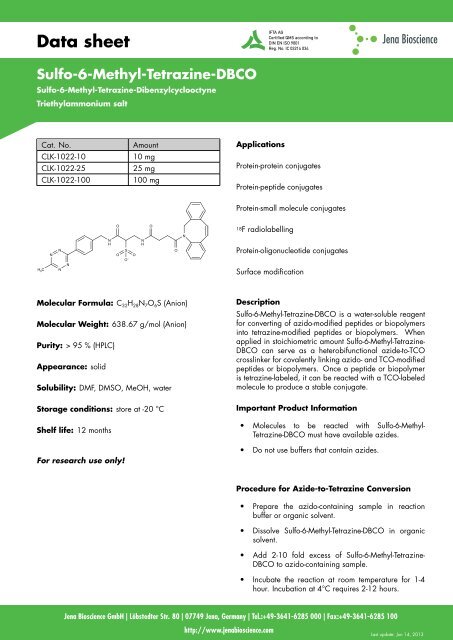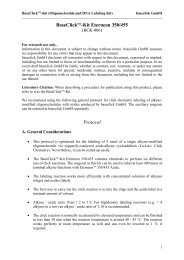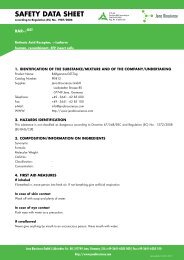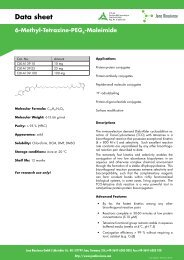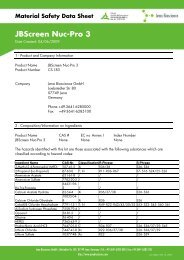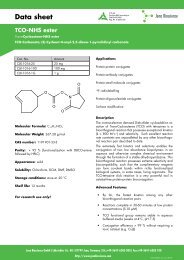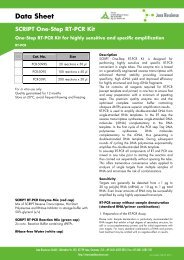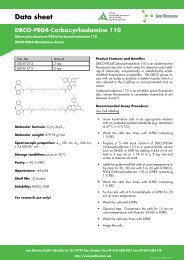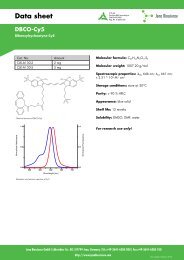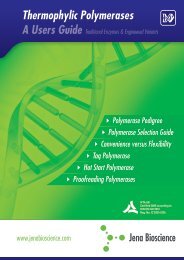Data sheet Sulfo-6-Methyl-Tetrazine-DBCO - Jena Bioscience
Data sheet Sulfo-6-Methyl-Tetrazine-DBCO - Jena Bioscience
Data sheet Sulfo-6-Methyl-Tetrazine-DBCO - Jena Bioscience
Create successful ePaper yourself
Turn your PDF publications into a flip-book with our unique Google optimized e-Paper software.
<strong>Data</strong> <strong>sheet</strong><br />
<strong>Sulfo</strong>-6-<strong>Methyl</strong>-<strong>Tetrazine</strong>-<strong>DBCO</strong><br />
<strong>Sulfo</strong>-6-<strong>Methyl</strong>-<strong>Tetrazine</strong>-Dibenzylcyclooctyne<br />
Triethylammonium salt<br />
Cat. No.<br />
CLK-1022-10<br />
CLK-1022-25<br />
CLK-1022-100<br />
Amount<br />
10 mg<br />
25 mg<br />
100 mg<br />
Applications<br />
Protein-protein conjugates<br />
Protein-peptide conjugates<br />
Protein-small molecule conjugates<br />
O<br />
O<br />
18F radiolabelling<br />
H 3 C<br />
N<br />
N<br />
N<br />
N<br />
N<br />
H<br />
O<br />
S<br />
O –<br />
O<br />
N<br />
H<br />
O<br />
N<br />
Protein-oligonucleotide conjugates<br />
Surface modification<br />
Molecular Formula: C 32 H 28 N 7 O 6 S (Anion)<br />
Molecular Weight: 638.67 g/mol (Anion)<br />
Purity: > 95 % (HPLC)<br />
Appearance: solid<br />
Solubility: DMF, DMSO, MeOH, water<br />
Storage conditions: store at -20 °C<br />
Shelf life: 12 months<br />
For research use only!<br />
Description<br />
<strong>Sulfo</strong>-6-<strong>Methyl</strong>-<strong>Tetrazine</strong>-<strong>DBCO</strong> is a water-soluble reagent<br />
for converting of azido-modified peptides or biopolymers<br />
into tetrazine-modified peptides or biopolymers. When<br />
applied in stoichiometric amount <strong>Sulfo</strong>-6-<strong>Methyl</strong>-<strong>Tetrazine</strong>-<br />
<strong>DBCO</strong> can serve as a heterobifunctional azide-to-TCO<br />
crosslinker for covalently linking azido- and TCO-modified<br />
peptides or biopolymers. Once a peptide or biopolymer<br />
is tetrazine-labeled, it can be reacted with a TCO-labeled<br />
molecule to produce a stable conjugate.<br />
Important Product Information<br />
• Molecules to be reacted with <strong>Sulfo</strong>-6-<strong>Methyl</strong>-<br />
<strong>Tetrazine</strong>-<strong>DBCO</strong> must have available azides.<br />
• Do not use buffers that contain azides.<br />
Procedure for Azide-to-<strong>Tetrazine</strong> Conversion<br />
• Prepare the azido-containing sample in reaction<br />
buffer or organic solvent.<br />
• Dissolve <strong>Sulfo</strong>-6-<strong>Methyl</strong>-<strong>Tetrazine</strong>-<strong>DBCO</strong> in organic<br />
solvent.<br />
• Add 2-10 fold excess of <strong>Sulfo</strong>-6-<strong>Methyl</strong>-<strong>Tetrazine</strong>-<br />
<strong>DBCO</strong> to azido-containing sample.<br />
• Incubate the reaction at room temperature for 1-4<br />
hour. Incubation at 4°C requires 2-12 hours.<br />
<strong>Jena</strong> <strong>Bioscience</strong> GmbH | Löbstedter Str. 80 | 07749 <strong>Jena</strong>, Germany | Tel.:+49-3641-6285 000 | Fax:+49-3641-6285 100<br />
http://www.jenabioscience.com<br />
Last update: Jun 14, 2013
<strong>Data</strong> <strong>sheet</strong><br />
<strong>Sulfo</strong>-6-<strong>Methyl</strong>-<strong>Tetrazine</strong>-<strong>DBCO</strong><br />
<strong>Sulfo</strong>-6-<strong>Methyl</strong>-<strong>Tetrazine</strong>-Dibenzylcyclooctyne<br />
Triethylammonium salt<br />
• Remove excess reagent by desalting the labeled<br />
protein through a desalt spin column or by azidemodified<br />
agarose.<br />
Procedure for TCO-<strong>Tetrazine</strong> Conjugation<br />
• Calculate 1.1 - 5 fold molar excess of tetrazineor<br />
TCO-modified biopolymer over the corresponding<br />
complimentary reagent.<br />
• Mix calculated amount of tetrazine-labeled biopolymer<br />
with desired amount of TCO-modified biopolymer.<br />
• Allow reaction to proceed for 30 minutes at room<br />
temperature. Longer reaction time might improve<br />
conjugation efficiency.<br />
Selected References:<br />
Karver et al. (2012) Bioorthogonal Reaction Pairs Enable Simultaneous,<br />
Selective, Multi-Target Imaging. Angew. Chem. Int. Ed. 51:920.<br />
Devaraj et al. (2009) Fast and Sensitive Pre-Targeted Labeling of<br />
Cancer Cells through a <strong>Tetrazine</strong>/trans-Cyclooctene Cycloaddition.<br />
Angew. Chem. Int. Ed. 48:7013.<br />
Haun et al. (2009) Probing Intracellular Biomarkers and Mediators of<br />
Cell Activation Using Nanosensor and Bioorthogonal Chemistry. ACS<br />
Nano. 5:3204.<br />
Blackman et al. (2008) <strong>Tetrazine</strong> Ligation: Fast Bioconjugation Based<br />
on Inverse-Electron-Demand Diels-Alder Reactivity. J. Am. Chem. Soc.<br />
130:13518.<br />
Devaraj et al. (2008) <strong>Tetrazine</strong>-Based Cycloadditions: Application to<br />
Pretargeted Live Cell Imaging. Bioconjugate Chem. 19:2297.<br />
• Store conjugate at 4°C until ready for purification or<br />
use.<br />
<strong>Jena</strong> <strong>Bioscience</strong> GmbH | Löbstedter Str. 80 | 07749 <strong>Jena</strong>, Germany | Tel.:+49-3641-6285 000 | Fax:+49-3641-6285 100<br />
http://www.jenabioscience.com<br />
Last update: Jun 14, 2013


